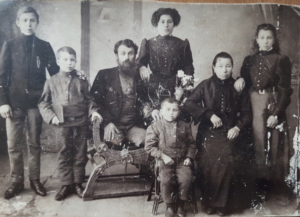When Laurie Gandel Samuels became a grandmother in 2020, she wanted to put together a family history for the two grandchildren.
“It was supposed to be almost a little craft project, with pictures of their parents or grandparents or great-grandparents and like a page of information on each person for a child to look at, up until maybe they’re 12 or something,” the Bucks County resident said.

She did not expect her grandchildren’s first birthday present to turn into an in-depth research project that led to many late nights and reunions with family members she had no idea existed.
“I just got so interested in it that, as my kids said, I went down the rabbit hole,” she said.
She knew her mother came from a large immigrant family whose members lived nearby, but her father’s side was more mysterious. He never spoke much about his family, and his parents died before she was born. In January, she transferred the results of a 23andMe DNA test she had taken years ago to MyHeritage, another genealogy site for people looking to build their family trees, to learn more.
She saw she had a strong match with a German woman named Larissa and her son Leo (they asked that their last names not be used for this story.) They shared about as much DNA as Samuels did with her known first cousins.
Intrigued, she reached out to them. Leo spoke English and connected her with Larissa. The latter was on the site looking for information about Morris Gendel, a name Samuels didn’t recognize. Larissa sent her an old family photograph showing a man with two leg amputations, his wife and their five children, one of whom was the man she was tracing. They had lived in Mogilev, Belarus.
While corresponding with Larissa and Leo, Samuels used her test results and interviews with known family members to track down other paternal family members she had never met. She created a Facebook group for them to communicate and added Larissa, even though they weren’t sure how they were related.
As the members compared notes and family stories, Samuels and Larissa learned that the man in the photo with leg amputations was Samuels’ grandfather’s eldest brother, Chaim Gendel (the spelling of Samuels’ grandfather’s last name changed to Gandel when he arrived in the United States.) A family member said he was a soldier who served in the Russo-Japanese War near the turn of the 20th century, and sustained his injuries during his service.
All of Chaim Gendel’s siblings, including Samuels’ grandfather Louis Gandel, immigrated to the United States, but he was unable to secure a visa. Of his five children, four immigrated to the U.S. Only the youngest, Lazar Gendel, stayed behind. He was Larissa’s grandfather.
The two women finally understood how they were related — Samuels’ grandfather Louis Gandel and Larissa’s great-grandfather Chaim Gendel were brothers.
Larissa was still searching for answers about her great-uncle Morris Gendel. Her grandfather had told her stories about his older brother sending letters, photographs, money and packages of items from the U.S. that the family sold for food.
In an email, Larissa said the correspondence continued even through the horrors of World War II, when the Russian government moved the family to a safer location because of Chaim Gendel’s service as a veteran. Later, Mogilev would be occupied by the Nazis and Jews would be crowded into ghettos and killed in mass executions.
Larissa said Lazar Gendel also fought at Stalingrad, where he was seriously wounded, and left her grandmother to care for the family. The clothing and money from Morris Gendel were a lifeline.
“My mother told me that during the war there was hunger and cold,” she wrote. “It was so cold in the apartment that the water in the glass turned to ice. These parcels helped them to survive.”
She told Samuels that the Gendels in the Soviet Union burned many of the brother’s letters in the late 1930s out of fear that materials from the United States would cause the government to think they were spies.
In 1961, during the Cold War, the letters from Morris Gendel stopped. Hostility between the Soviet Union and the United States intensified, and mail could not travel between the two countries. By the time correspondence resumed, Morris Gendel had moved and the family lost track of his address. They sent letters trying to reach him again, but they were returned unopened.
The connection between the European and American branches of the family was severed until Samuels began researching her DNA test results in 2021.
Leo tracked down a wedding announcement for Sandra Kahn, a woman he and his mother believed to be Morris Gendel’s daughter, in a newspaper from Newark, New Jersey. They located her on Facebook and reached out, but she had not responded, and they felt they had hit a dead end.
Samuels looked up Kahn and also identified her relatives. She began sending them messages and friend requests to see if she could get a response.
Finally, Kahn’s niece Sharon Lynn Levitz replied. Samuels showed her the photo of Morris Gendel that Larissa had sent, and Levitz confirmed that he was her grandfather. She also recognized the return address from the letters that Larissa saved as the house in Newark where her grandparents had lived for many years. She put Samuels in touch with Kahn, who was now 90, and they spoke on the phone.
Samuels and Larissa had found the missing branch of their family.
“This story … it’s the miracle of a family that survived over all this time, and they survived because this brother was so loyal,” Samuels said.
Her Facebook group of reconnected family members now has 14 people. She is still using her results to track down relatives who may be descended from her grandfather’s siblings.
[email protected]; 215-832-0729



